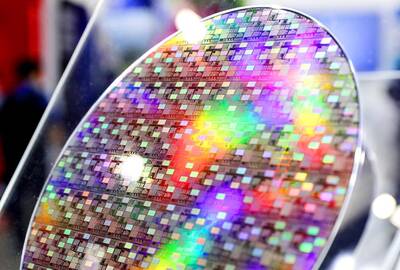As Honda prepares to lease a handful of fuel-cell cars to consumers, General Motors is offering its own hydrogen cars free.
GM is due to roll out Project Driveway next month, which will park more than 100 Equinox Fuel Cell crossover wagons with selected drivers in Westchester County, New York; Orange County, California; and Washington.
UNIQUE FLEET
GM said the research project would give it the world's largest fleet of fuel-cell cars driven by consumers, who can apply for no-cost, three-month tests of the Equinox online.
For recipients of the Equinox, each valued at up to US$1 million, GM will even cover the cost of hydrogen fuel and insurance.
Like other fuel-cell cars, the Equinox generates electricity from a reaction between hydrogen and oxygen -- without smog-forming emissions or greenhouse gases. The crossover wagon delivers the equivalent of about 18.3km per liter and can travel roughly 274km on a tank that holds 4kg of pressurized hydrogen. Each kilogram contains roughly the energy of 3.8 liters of gasoline.
Initial Project Driveway recipients have been selected, but GM said it would choose among contenders for 2009 test drives. The company expected several hundred people to test the Equinox through 2010.
While Honda calls the new FCX a production car, fuel-cell vehicles don't really qualify, at least as most people understand the term: No consumer can simply place an order, and no current models are available at dealerships. People chosen to drive the Chevy or lease the FCX must return the vehicle when the term is up.
Instead, these demonstration cars allow the companies to pile up real-world miles, data and owner feedback. Among GM's selection criteria, testers must be willing to keep ownership logs and report on their experiences.
The vehicles also provide street-legal proof that fuel cells can be harnessed in an otherwise typical car. Seeing them running smoothly -- and not bursting into flame like the Hindenburg -- could ease consumer skepticism over hydrogen safety and reliability.
OTHER AUTOMAKERS
Several other automakers are developing and testing hydrogen models.
Ford has 30 fuel-cell Focus compacts in use around the world, largely in municipal and corporate fleets. BMW has lent 25 copies of its Hydrogen 7 to celebrities, including Will Farrell and Jay Leno.
The revamped 7-Series sedan burns gasoline or hydrogen in an internal combustion V-12 engine rather than using a fuel cell.
Of course, hydrogen is still hard to come by. The scarce fueling infrastructure means that Equinox testers must live or work near hydrogen stations. In New York, there is a station in White Plains. GM expects stations in the Bronx and near Kennedy Airport to open by March.
Ben Knight, Honda's research and development chief in the US, said in an interview that Honda realistically saw 2018 to 2020 as the rough target for fuel-cell cars in showrooms. GM has continued to say it will have showroom-ready models much earlier, by 2011 or 2012.

WAITING GAME: The US has so far only offered a ‘best rate tariff,’ which officials assume is about 15 percent, the same as Japan, a person familiar with the matter said Taiwan and the US have completed “technical consultations” regarding tariffs and a finalized rate is expected to be released soon, Executive Yuan spokeswoman Michelle Lee (李慧芝) told a news conference yesterday, as a 90-day pause on US President Donald Trump’s “reciprocal” tariffs is set to expire today. The two countries have reached a “certain degree of consensus” on issues such as tariffs, nontariff trade barriers, trade facilitation, supply chain resilience and economic security, Lee said. They also discussed opportunities for cooperation, investment and procurement, she said. A joint statement is still being negotiated and would be released once the US government has made

NEW GEAR: On top of the new Tien Kung IV air defense missiles, the military is expected to place orders for a new combat vehicle next year for delivery in 2028 Mass production of Tien Kung IV (Sky Bow IV) missiles is expected to start next year, with plans to order 122 pods, the Ministry of National Defense’s (MND) latest list of regulated military material showed. The document said that the armed forces would obtain 46 pods of the air defense missiles next year and 76 pods the year after that. The Tien Kung IV is designed to intercept cruise missiles and ballistic missiles to an altitude of 70km, compared with the 60km maximum altitude achieved by the Missile Segment Enhancement variant of PAC-3 systems. A defense source said yesterday that the number of

‘CRUDE’: The potential countermeasure is in response to South Africa renaming Taiwan’s representative offices and the insistence that it move out of Pretoria Taiwan is considering banning exports of semiconductors to South Africa after the latter unilaterally downgraded and changed the names of Taiwan’s two representative offices, the Ministry of Foreign Affairs (MOFA) said yesterday. On Monday last week, the South African Department of International Relations and Cooperation unilaterally released a statement saying that, as of April 1, the Taipei Liaison Offices in Pretoria and Cape Town had been renamed the “Taipei Commercial Office in Johannesburg” and the “Taipei Commercial Office in Cape Town.” Citing UN General Assembly Resolution 2758, it said that South Africa “recognizes the People’s Republic of China (PRC) as the sole

Taiwanese exports to the US are to be subject to a 20 percent tariff starting on Thursday next week, according to an executive order signed by US President Donald Trump yesterday. The 20 percent levy was the same as the tariffs imposed on Vietnam, Sri Lanka and Bangladesh by Trump. It was higher than the tariffs imposed on Japan, South Korea and the EU (15 percent), as well as those on the Philippines (19 percent). A Taiwan official with knowledge of the matter said it is a "phased" tariff rate, and negotiations would continue. "Once negotiations conclude, Taiwan will obtain a better